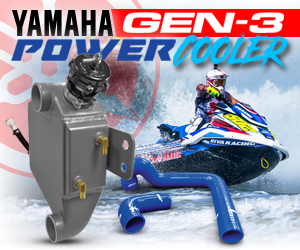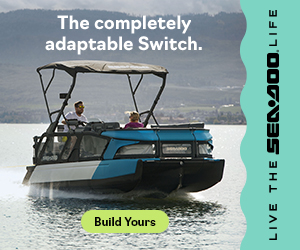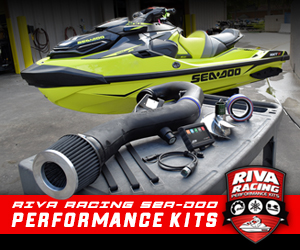We’ve ridden our fair share of race-prepped watercraft over the years; both modified and piloted by some of the most prolific athletes in the sport of personal watercraft racing – from 90-plus-mile per hour drag racers to laser-precise, hairpin-cutting closed course machines, and pretty much everything in-between.
So when we say authoritatively that the newly redesigned 2021 Yamaha GP1800R SVHO WaveRunner (MSRP $14,749) is the single best platform from which to dominate the world of racing that we’ve seen in at least the last decade – if not past 20 years or so – please understand that it’s coming from a place of experience.
Today’s redesign began just over two short years ago, as marching orders came down from corporate that Yamaha wanted to “freshen up the VX line”. Project Manager Scott Watkins and his research & development team quickly began culling through notes gathered by the world’s best riders and years of testing. Certainly, the past four years of national and world championships earned the GP1800R legend status, but as Scott told The Watercraft Journal, “There still was plenty left on the table.”
For 2021, Yamaha re-engineered its GP1800R musclecraft by focusing on four key characteristics: improving rider ergonomics, weight distribution, acceleration and cornering.
Beginning with a wholly redesigned deck, the GP’s upper half borrows heavily from both the entry-level EX line as well as Yamaha’s full-sized FX Series. The upper half of the WaveRunner is now a two-piece, employing a plastic secondary deck panel – similar to those first used on the EX WaveRunners. When removed, the near entirety of the engine compartment is exposed, making access to the supercharged and intercooled SVHO engine and exhaust system demonstrably easier.
This second-deck also allowed Yamaha to provide riders a far racier saddle. Curved and contoured to allow greater range of motion – particularly if you’re dropping a knee into the deeper, wider and self-draining footwells as you enter into a high speed corner – the new seat features a high bolstered back that’s wrapped in a grippy, traction-enhancing material so the g-forces can’t pull you out of the seat as easily (but they still will).
The reshaped saddle is 1.5-inches narrower and tapered at the knees, allowing the driver better lower-body grip in cornering and comfort while cruising. Coves at the knees open up the rider to easier foot placement and leg movement too. The GP1800R’s new hood and fairings are also entirely new – and surprisingly “retro” in our view, drawing a few styling cues from the GP1300Rs of years passed.
Adding to the GP’s newfound ergonomics are all-new color-matched pistol grip-mounted, tilt-adjustable handlebars. With five settings of adjustment to choose from, taller riders can finally enjoy standing upright with the bars set at their highest without having to stoop over. And if you’re looking at tucking in low and snapping a hard S-turn, the lowest setting drops the bars down into the cowling perfectly.
Equally, the control pods on the handlebars have been wholly redesigned, with a single Start/Stop button now on the right-hand side, and the Cruise Assist/No Wake Mode button on the left. (The electric trim and cruising throttle toggles remain in their same places though but also have been redesigned and are more responsive to quick inputs.)
Ahead of the handlebars is the GP1800R’s full-color “Helm Control” digital dashboard. The 4.3-inch Yamaha Connext dash is not a touchscreen like the FX, but is controlled by a touchpad located beneath the steering on the right hand side. Riders can freely scroll through pages offering fuel mileage and consumption rates, a PIN security code and even pre-setting a maximum speed.
For the would-be racer, the GP1800R includes two new computer-controlled handling features: the first being “Launch Control” that digitally toggles the trim as the WaveRunner pulls hard from a standstill or idle speed; and second, the industry’s first Auto Trim system, exclusive to the GP models. Advertised as “Cornering Control,” the Auto Trim feature operates independently from the electric trim system on the handlebars.
When activated, “Cornering Control” automatically trims the bow down when decelerating for a tight corner. This action “loads” the hull’s surface tension prior to accelerating out of the apex of a corner. As the rider accelerates out of the apex, the Auto Trim will rise back up to plane as speed increases.
Cast into the fairings between the dashboard and handlebars are threaded portals for Yamaha’s multi-mount accessory system; simply screw in a RAM ball-mount and you can attach any number of items, like a GPS, action camera, etc. – sorry, no cup holders, guys.
If course, if you’re looking to really kit-out your GP1800R SVHO, Yamaha just introduced its first factory-installed marine audio system. The $800 option consists of twin 4.5-inch waterproof marine speakers, an integrated 2-channel (50 watts per channel) amplifier, and a low-voltage regulator to protect the battery; all of which is operated by an easy access control pad below the handle bars on the left hand side. And no, this sounds system WILL NOT retrofit on previous GP or VX models, as it is cast to fit the newly designed deck.
With the deck’s redesign also comes an all-new glovebox. Not only is it the largest glovebox ever offered for the GP Series, it’s also watertight and includes a removable rubber lining. (Although the exact same size inside, the opening for the GP’s glove box is a little tighter. And you’re going to have to check the option box for the blue LED-lit USB port and 12v socket that comes standard on the VX models.)
Base storage is also up to 28.4 gallons from 24.6 thanks in large part to the larger bow compartment, made wider for easier access and features a more durable, high strength hinge and gas-filled shock dampener; as well as a snap-top, water-resistant box found beneath the rear seat. And the new deck also gives the GP’s a wider rear swim platform, a wide folding swim step and molded-in reboarding handle as well.
Below the seat, the Super Vortex High Output 1,812cc 4-cylinder four-stroke remains mostly unchanged. Although not advertised, two changes were made to the GP’s powertrain; a redesigned supercharger clutch that includes more teeth (27 vs. 24) and a larger diameter. This means greater engagement throughout the RPM range. The SVHO’s total power output remains the same, but is now significantly more efficient.
Secondly, the transom plate has been machined wider, from 155mm to 160mm, permitting a more stable flow of water into the pump. Gone is the abrupt step in the aluminum transom; instead, it’s a true 160mm that flows into the one-piece pump with a removable 160mm liner and impeller, and a tapered stator with a 160mm exit.
Feeding the larger pump inlet is re-developed top loader intake grate. Featuring a stepped wing blade design and dramatically increased chip-inlet, the all-new top loader grate increases volume and traction while reducing cavitation, veritable one-two punch when it comes to initial acceleration and rough water hook-up.
Yet, easily the biggest change to the GP1800R is the one that will likely go the least noticed: although the GP1800R’s hull below the bondline remains unchanged for 2021, the inner hull liner was redesigned, moving the 18.5-gallon fuel tank 3.15-inches back and half-an-inch deeper down. This move alone dramatically readjusts the craft’s center of gravity and neutral pivot point.
So what does that mean? No longer does the GP1800R feel like its cornering from behind the rider, but directly below them, radically improving the WaveRunner’s handling and overall agility. These changes have fine-tuned the GP1800R SVHO into an entirely new machine. We must stress that we’re not being hyperbolic here. The 2021 Yamaha GP1800R SVHO rolls smoother into a turn and out through the apex than any WaveRunner before it.
No, the 68-and-a-half mile-per-hour top speed hasn’t changed, but getting there is a whole different experience. Instantaneous hookup and an unceasing mid-range that lifts into the boost curve has made the 2021 GP1800R easily one of the most exciting personal watercraft we’ve seen a mainstream manufacturer build. Add that to its newfound cornering prowess and you’ve got a ski that pulls harder out of a corner like a hand-built race craft.
Before, the previous GP1800R SVHO would almost leap out of the water as it tried to accelerate. Now, launching from idle is a totally different experience; initial cavitation is almost nonexistent, and the GP’s super-balanced inside lean through a hairpin is all-the-more predictable.
Yeah, the new unit picks up half an inch in height (47.2” vs. 46.9″) and two-and-a-half extra pounds (772-pounds vs. 769-pounds, dry weight) over last year, but isn’t much to cry about. The NanoXcel2 hull and deck material still shaving off 18-percent more weight than the standard NanoXcel material, giving the Yamaha it’s excellent power-to-weight ratio.
Again, looking from the outside the changes appear to be merely cosmetic: 15-percent more storage? Sure. The multi-mount accessory system and the full-color Connext Helm Control? Yeah, you betcha. Even an optional sound system. Yeah, that’s pretty cool too. But it’s truly what’s under the skin that makes the new race-ready 2021 Yamaha GP1800R SVHO the single-most aggressive WaveRunner we’ve seen leave the assembly line.
































































I want to try it as well as the 2021 RXPX300. They are going to make for fascinating challengers on the Racing Circuit – can’t remember if there is a Stock category anymore in the IJSBA but that would be the true test.
Yes there is, and Pro Stock Runabout at 2019’s IJSBA World Finals was LITERALLY only GPs and FXs.
Great article and video, as always! Pre-ordered mine and can’t wait to ride it! What camera system/set up are you using at the 4:40 mark? Thats a great shot. Thanks!
We use mainly GoPro and Insta360 cameras.
Great article. What’s horsepower for 2021 GP1800?.
255
Hi Kevin, Great Review. As so many I’m inbetween the fx cruiser shvo and gp1800r shvo. It would be great if you could do a comparison video. In your opinion how much of the „racing handling/ characteristic“ u give up for a more space and better chop handling.
Thanks Alex.
If you’re “on the fence” just go ahead and get the FX.
HI Kevin, another very professional article and reviw ! thank you . My question is : do you think that picking the 1800r HO rathen than the SVHO will make youo suffer a lot less maintenance problems due to the supercharger ? A sales agent just told me that , but I’d like more opinions before making my decision .
There is definitely less upkeep on a naturally-aspirated engine. Equally, you’ll enjoy better fuel mileage, which is always nice.